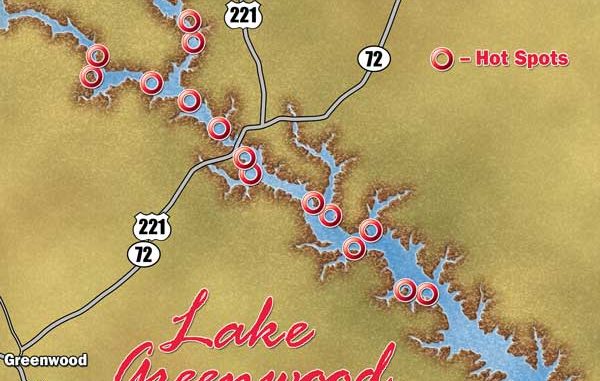
Lake Greenwood is the winter destination for quality catfish.
Cold weather catfishing is popular on many lakes across the Palmetto State, but one lake overlooked by many anglers is Lake Greenwood.
This cold-weather fishery won’t go unnoticed for long, because catfishing opportunities are rapidly expanding. The booming channel catfish population is being reinforced with whiskered recruits from a steadily-growing population of flatheads.
December is prime time, especially for trophy-sized catfish.
Chris Simpson is a full-time fishing guide who lives in Ninety Six. He fishes his home waters of Lake Greenwood much of the year but really focuses on the lake during cold weather and believes the trophy channel catfishing is better at Lake Greenwood than anywhere else.
“In terms of trophy channel catfish, I believe there is a better opportunity to catch a double digit-sized channel catfish from Lake Greenwood than anywhere else in the state,” said Simpson (864-992-2352). “I know the world record is from Santee Cooper, but that was years ago. During the winter, the average size of the channel catfish we catch in Lake Greenwood will be in the 6- to 8-pound class. December though April is the prime time to catch the biggest catfish of the year.
“Lake Greenwood has long been an outstanding catfish lake, but with the combination of the channel catfish that we already have and the fast growing populating of flatheads, I expect Greenwood to soon be considered one of the top all-around catfish lakes anywhere.”
Simpson has caught a few large blue catfish in Lake Greenwood as well. This year, however, he hasn’t caught any small blue catfish. He said he doesn’t know if they are reproducing or not, at least yet.
“But it is clear the flatheads have expanded and offer a very good fishery already,” said Simpson, 28, who has two basic patterns for cold-weather fishing on Lake Greenwood: drifting, or anchoring and fishing specific underwater structures. Specific times and conditions make each one reliable for different reasons.
Drifting is the technique Simpson uses most frequently, especially when he’s guiding, because the action is usually faster. He can cover more water while looking for a big concentration of catfish.
But when conditions get right, such as extremely cold weather after a major frontal passage, Simpson said catfish will often hold on specific kinds of structures: brush, logs or other bottom debris. In those cases, anchoring and casting must more productive.
If he’s looking for a really big channel or flathead, he said anchoring is his favorite method.
“Anchoring is the best way to catch a trophy channel catfish or big flatheads during the winter,” he said. “Probably 70 percent of the channel catfish will bite when I’m anchored. It’s also the way I most frequently catch flatheads as well, so that doubles the big fish opportunity. But the trade-off is that sometimes we don’t catch as many fish when anchored.
“One factor that helps me decide is what my client wants to accomplish. But both anchoring and drifting will usually generate a good number of bites during the day.
“Anchoring takes a lot more patience. When anchoring, I’ll give a place at least 90 minutes before moving. When the water temperature really gets cold, the catfish don’t move as much to feed. The big catfish will begin to orient to humps along the river channel ledge and will often get along the edge of woody debris at this time of the year.”
Simpson is extremely precise in this anchoring technique. He has specific targets stored on his GPS and will use the wind and current to get his boat in the exact place he wants it, then he’ll fan cast baits around the boat.
“Often, we’ll have to sit for a while with little action,” he said. “Then we’ll get several bites quickly and usually catch some good fish. On the other hand, sometimes I’ll start hooking fish before I get all the rods out. But my advice is to give it the full 90 minutes. I’ve had a number of times when I had decided to leave in five more minutes, only to have the fish start biting like crazy.”
Simpson said anchoring is a great way to hook big flatheads during the winter, but they’re caught while drifting as well. He knows of flatheads in the 60-pound class caught from Greenwood. Typically, they will weigh between 15 and 20 pounds.
“We don’t catch big flatheads every day during the winter,” he said. “However, it’s a fairly consistent bite. I may have a trip or two when it’s all channel catfish, but then we may catch two, three or four flatheads on any given day. Given their average size, we can pile up a bunch of weight in a short time when the flatheads turn on. Plus, we’re catching channel catfish as well.”
Craig Davidson of Greenville is another Lake Greenwood catfish specialist; he said he prefers to fish the drift bite during the cold months.
“One thing I’ve learned is that the catfish can be very specific in their location during the winter,” Davidson said. “The forage will move around, and as it does, so will the catfish. However, a lot of the times the best places to drift will be along the ledge of the river channel. On some days, it’s crucial that you drift right along the edge of that drop zone to consistently catch fish. There’s a lot of debris in the lake such as brushpiles for crappie, logs and stumps, and catfish will get around these palaces during the winter. We’ll lose some rigs in the cover, but you’ve often got to get in there to hook the catfish.”
He said that occasionally drifting flats away from the channel will produce, and the presence of schools of baitfish scattered over the flat is a key.
Davidson said that his best depths vary from 15 to 22 feet at the edge of the channel before it drops into the deep water. He usually fishes the upper half of he lake in the winter.
“During parts of the year, I’ll fish the lower end,” he said. “But during winter, there seems to be plenty of bait, and the depths are easier to effectively fish in the upper half of the lake,” he said.
Staying on top of the general location of the catfish is a key to success Davidson said, regardless of whether you anchor or drift fish. Also, he said he does not randomly drift. He has a specific plan.
“As the location of the forage fish changes, so will the feeding habits of the catfish,” said Davidson, who uses his electric trolling motor to keep his boat on course and at the speed of drift he prefers. Usually, a drift-speed range of a half-mile to three-quarters of a mile per hour is preferred.
Simpson said the combination of speed and depth are keys to consistent success.
“When drifting, I like to cover a decent amount of water, but if I get drifting too fast in the cold water, the bite may slow down,” he said. “On some days, it’s crucial to have just the right speed, so I keep experimenting until I get the speed and depth pattern for the day. When we get it right, the big fish bite is on.”


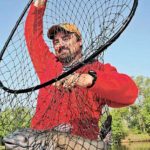
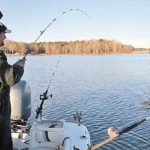
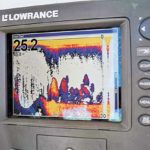
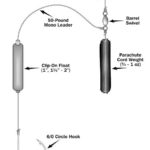
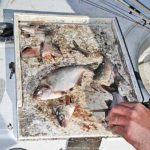



Be the first to comment